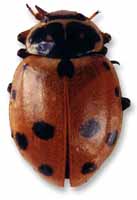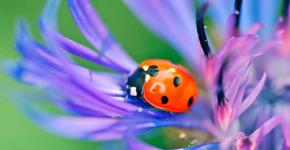Yellow ladybug: amazing facts about these insects. What is the difference between a yellow ladybug and a red ladybug?
Everyone knows such an insect as a ladybug. Each of us held this beetle in the palm of our hand and with curiosity counted the number of points on its back. Remember how in childhood we thought how many points - for so many years and for a ladybug, how the poems sang, begging us to fly to the sky ... An insect ladybird evokes joyful and enthusiastic memories from childhood. Below you will find a photo and description of a ladybug, you can learn a lot of new and unusual things about it.
Ladybug looks very small. The dimensions of a ladybug reach a length of 4 to 9 mm. Ladybug looks recognizable, because most often it is painted red and dotted with black dots. A ladybug has a bulging, almost round body. Ladybug looks interesting, because in the structure of her body so many small details.
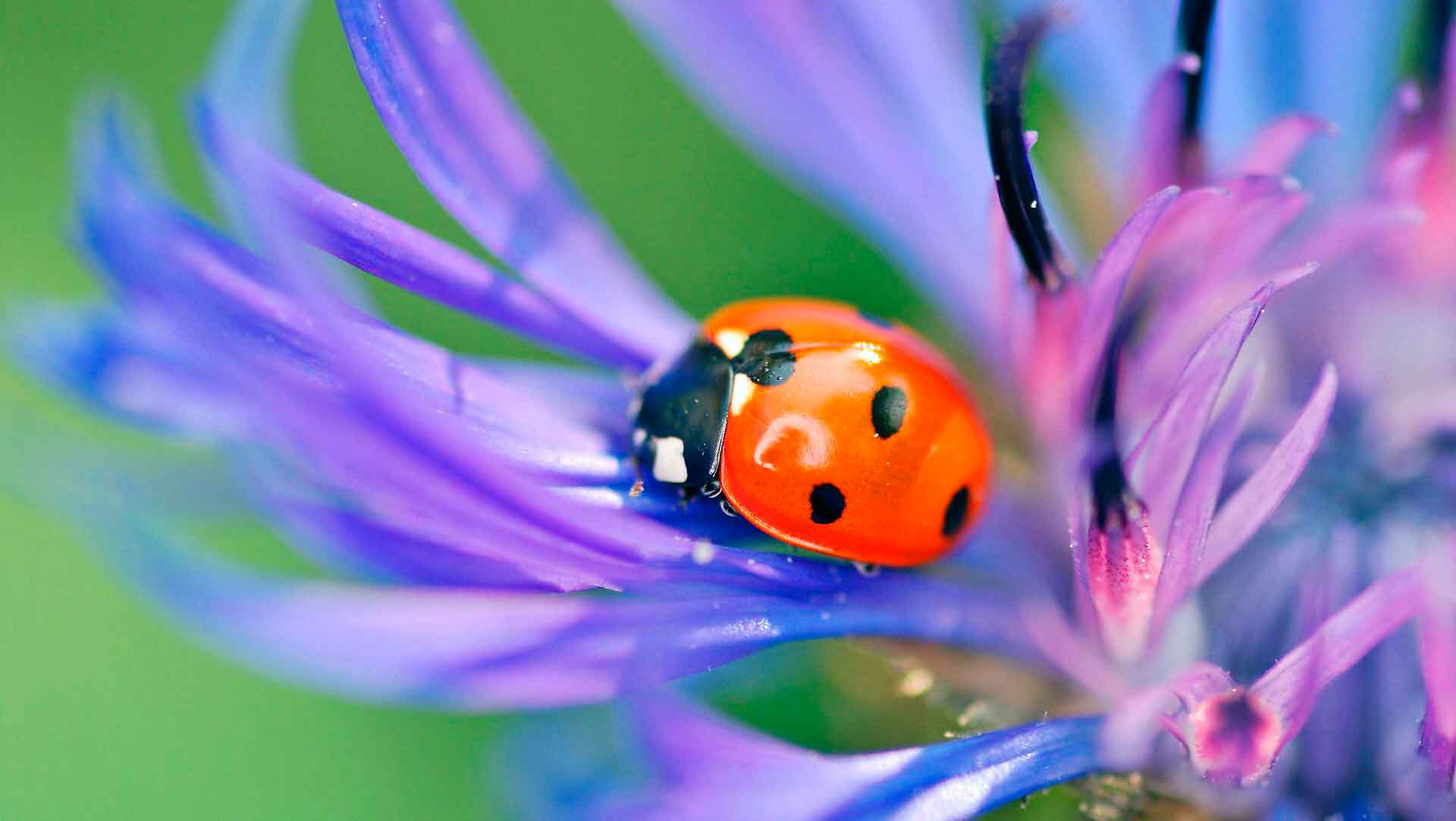
Insect ladybug has head, pronotum, chest, abdomen, winged wings and legs. The ladybird has a small and short head, which is still attached to the pronotum. On the head of the insect are the eyes and moving antennae. A ladybug beetle flies using a pair of hind wings. The front wings of a ladybug are hard elytra, which protect the main wings while it is on the ground. Ladybird flies perfectly and wings up to 85 strokes per second.
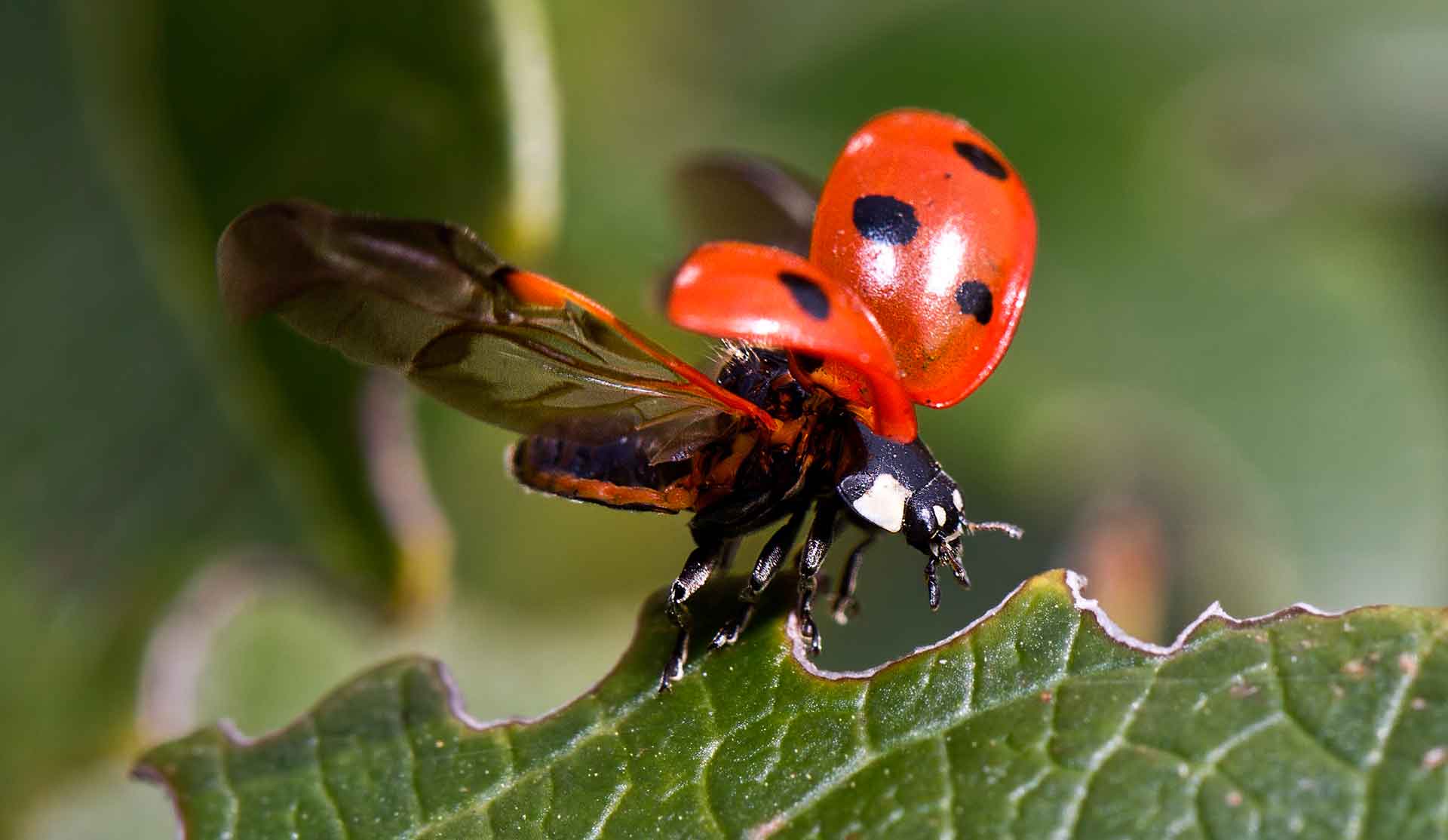
Everyone knows that a ladybug looks so bright to scare predators. In addition to the variegated colors, the ladybug also emits a yellow liquid with a sharp, specific odor. This liquid is poisonous and serves as protection against frogs, spiders and other potential enemies. Its poisonous liquid ladybug beetle allocates from the joints of the legs in case of danger. Also, when in danger, the insect can even pretend to be dead.
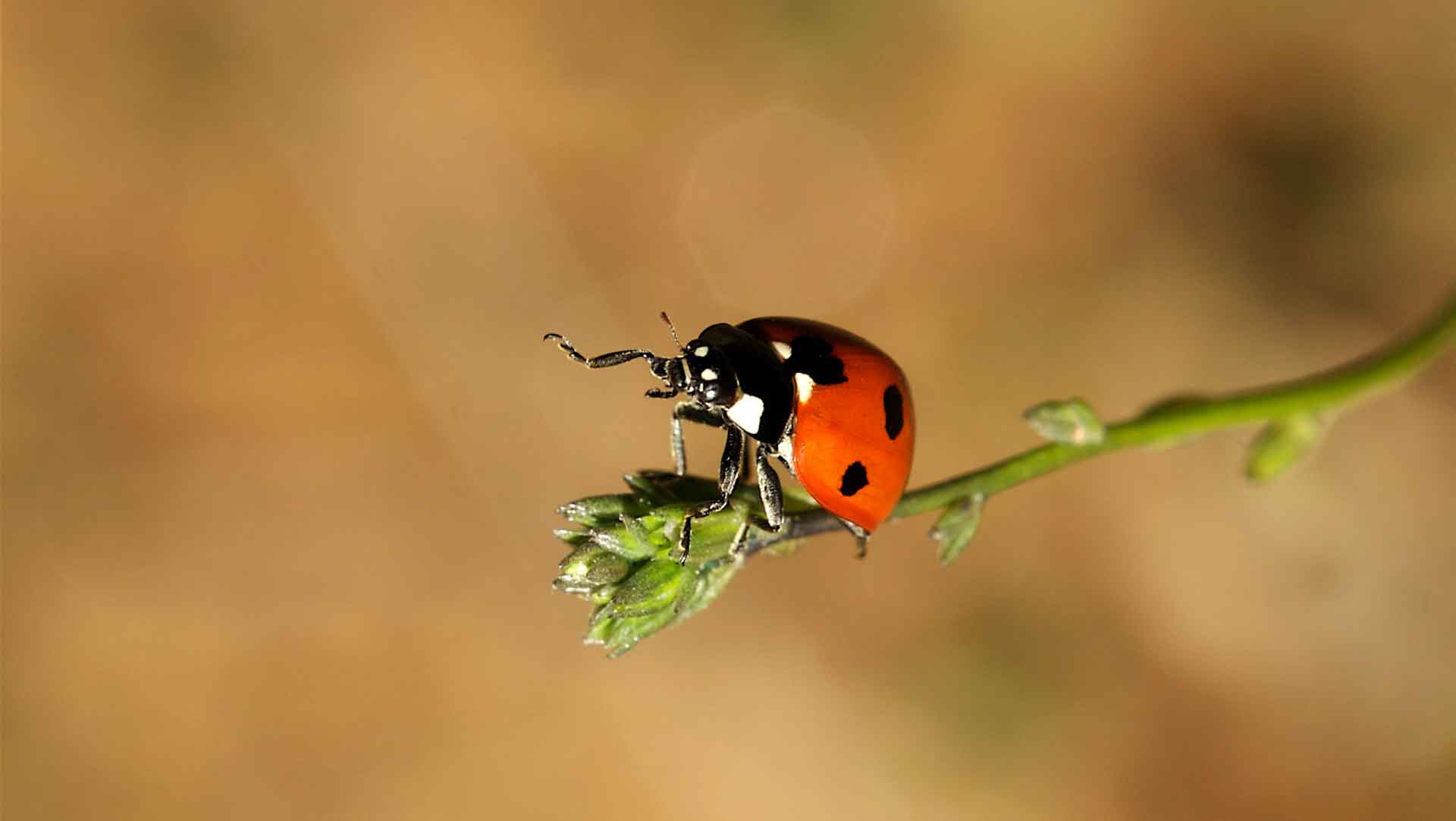
Of course, the red ladybug is not the only color solution for this insect. There is a yellow ladybug, a black ladybug and even a white ladybug. What a ladybug looks like and what color it will be depends on the type of ladybug. At the same time young individuals have the most saturated color, in older adults it tarnishes over time.

Types of ladybirds are very diverse. All of them have a different shape, size, color and number of points. There are even ladybugs without points. There are more than four thousand types of ladybirds, which are united in 360 genera and distributed in almost all parts of the world.

The most famous and common type of ladybirds, which is most familiar to us, is the seven-point ladybug. It has the usual red color for us, and is named like this because it has exactly 7 black dots. Below in the photo you can see different types of ladybirds.

Where does the ladybug live?
Ladybird lives almost everywhere except in the Arctic and Antarctic. Ladybird lives on trees, shrubs and grass in different parts of the world. Most often, a ladybug lives in the steppe zone, forests, mountains and gardens. In Russia, the ladybug lives on almost the entire territory, with the exception of the extreme northern regions. The ladybug also lives in Europe, Asia, Japan, China, India, Mongolia, Africa, Korea and America.

How does a ladybug live?
Ladybird lives, showing activity from early spring to late autumn. In winter, ladybirds hide under foliage, tree bark or stones, where they remain until spring. But not all ladybirds live sedentary and remain to spend the winter there, where they spent the summer. Often, before the onset of cold weather, ladybugs make flights.
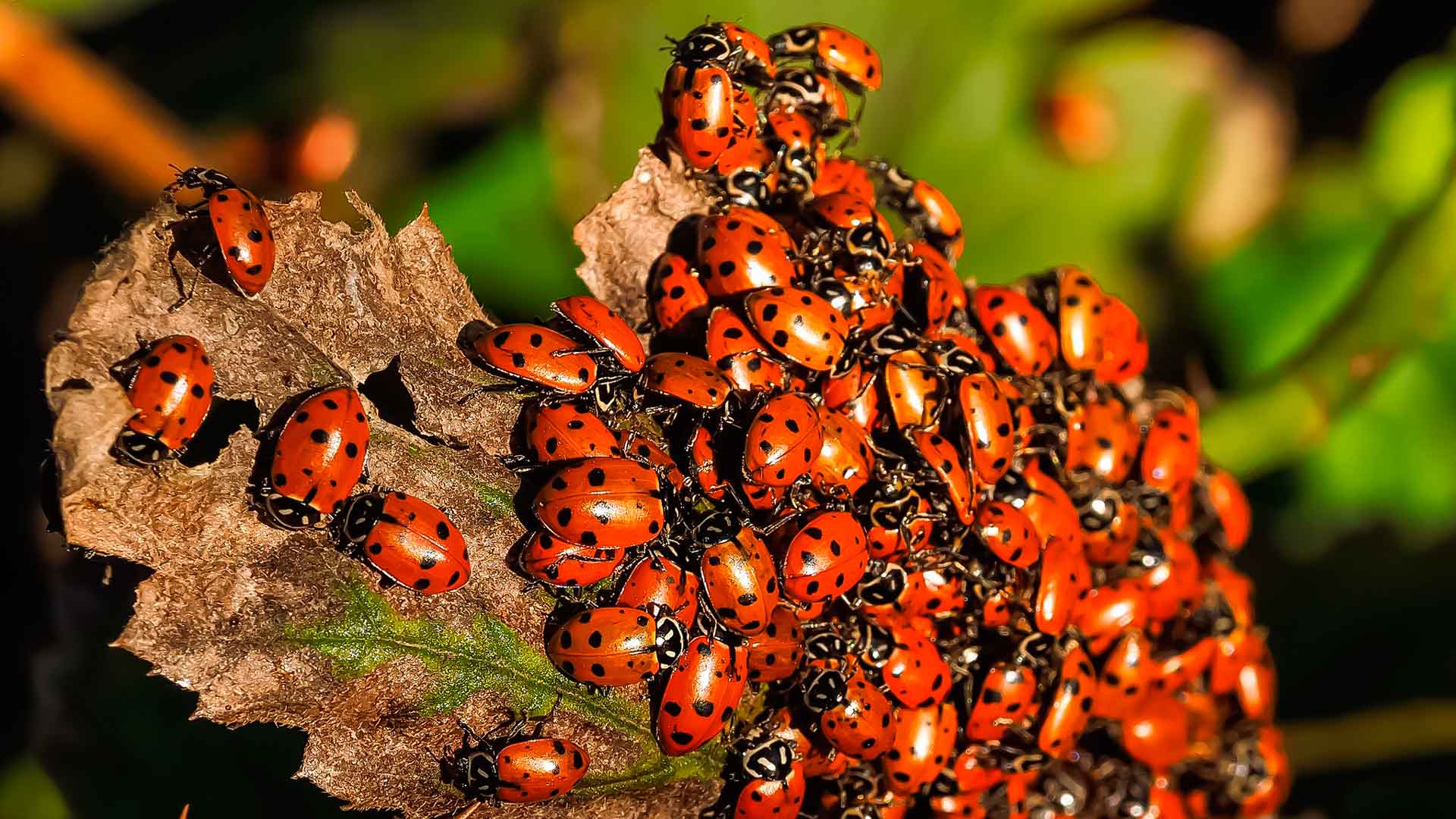
During periods of wintering and hops, ladybugs, usually leading a solitary lifestyle, come together. Also mass accumulations of this beetle are characteristic during the mating season. In the spring, the ladybird wakes up very early, for it is enough that the temperature reaches only + 10 ° C. Therefore, the ladybird can be seen one of the first after the winter. Ladybirds live from 10 to 12 months and only occasionally up to 2 years. The lifespan of a ladybug depends on the availability of food.

Probably for each of us will be a great discovery that most of the ladybirds are predators. Because ladybugs eat aphids. On the day a ladybug eats about a hundred aphids. In addition, the ladybugs eat leaf beetles, flaps, mites, and worms. The larva of a ladybug is also predatory. Both the ladybug and its larva are very voracious.
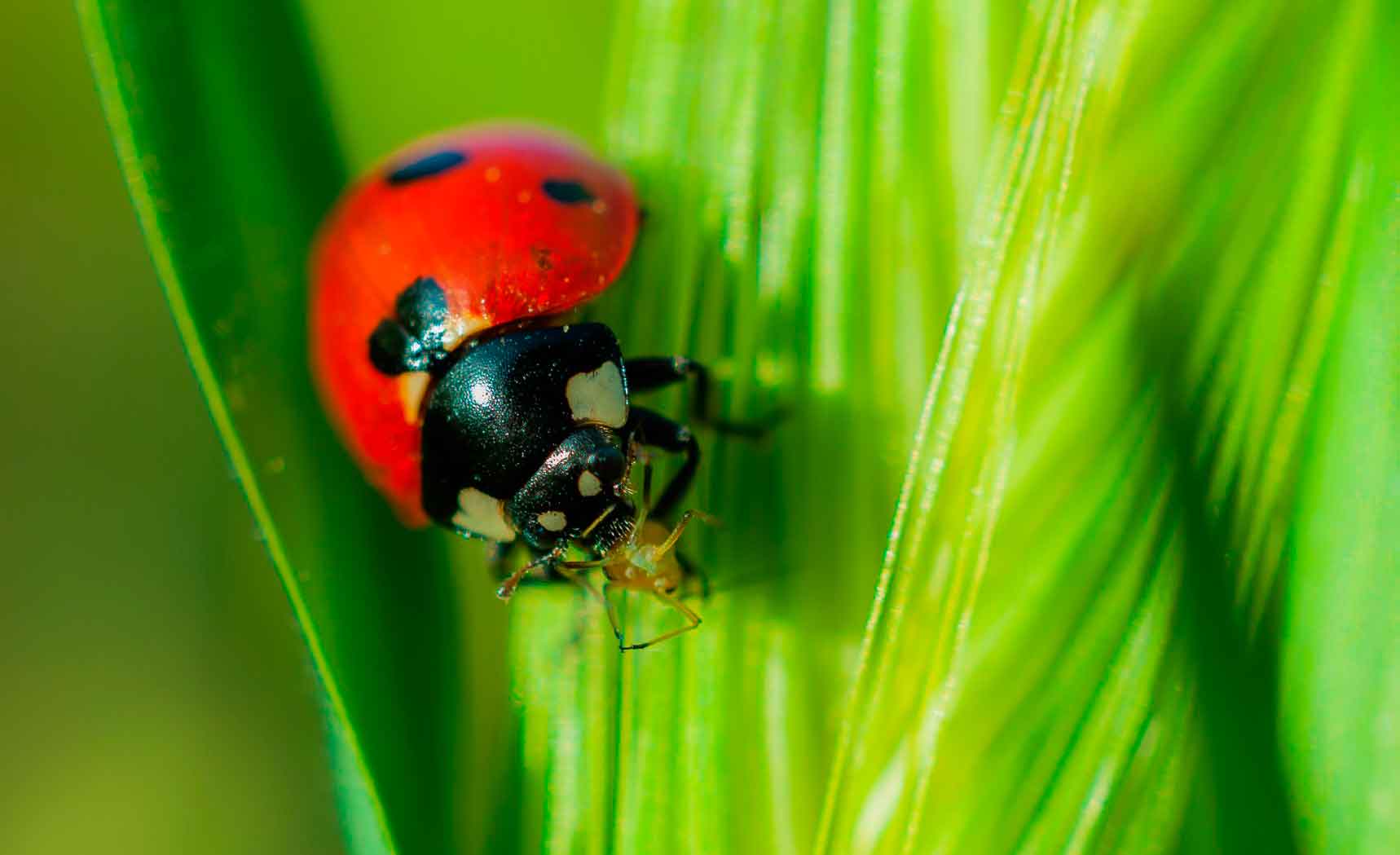
Insect ladybug in huge quantities destroys various dangerous pests, which brings great benefits to agriculture. A seven-spotted cow was even deliberately brought to America to fight spider mites and aphids.
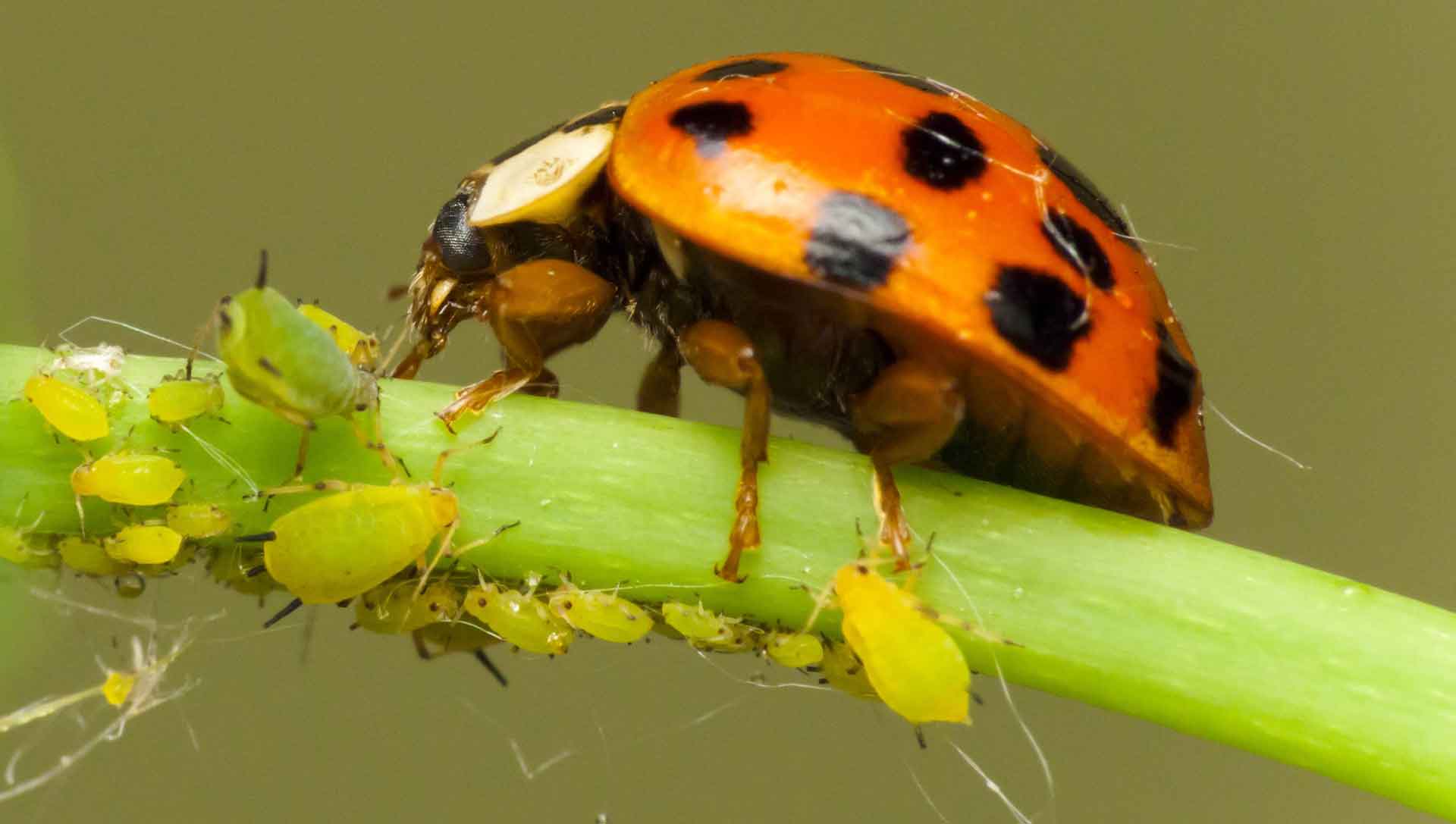
Of course, there are also herbivorous species of ladybirds. These ladybugs feed on plants and damage agriculture. Herbivorous ladybugs are most common in the tropics of all continents and subtropics of Southeast Asia.

In Russia, there are 3 types of ladybirds that feed on plants. Harm to potatoes, tomatoes, cucumbers and other vegetable crops is caused by a 28-point ladybird, an alfalfa ladybug damages sugar beet and alfalfa, and a stringless ladybug damages clover and sweet clover. All other types of ladybirds that live in Russia are predators.
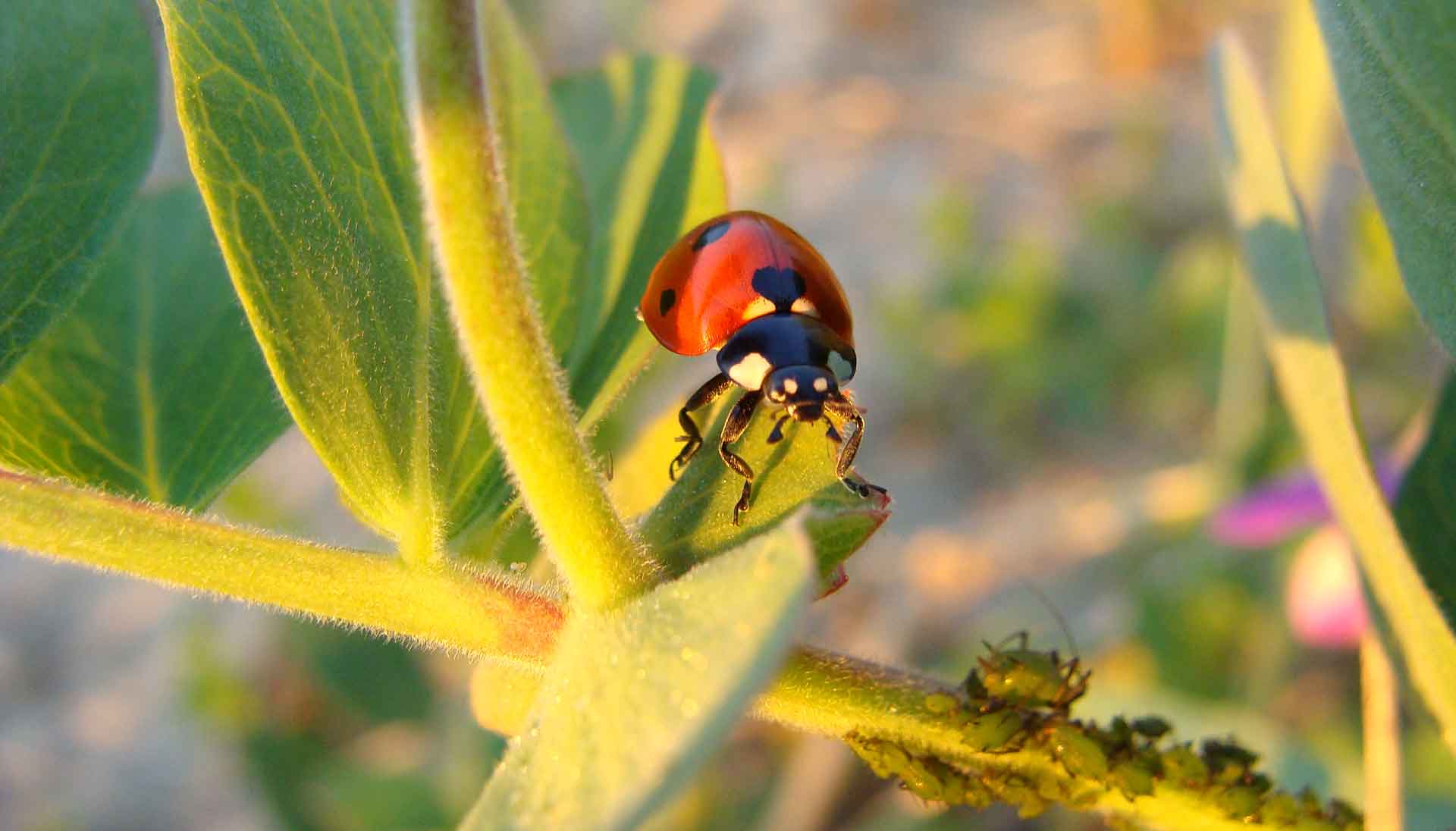
Ladybird Larva
The marriage period of ladybirds falls in the middle of spring, when insects have already gained strength after hibernation or hibernation. During the breeding period, the female allocates a special secret, according to which the male finds her. After that, the female lays eggs on plants. Ladybird chooses a place closer to the colonies of aphids, so that the offspring was provided with food.
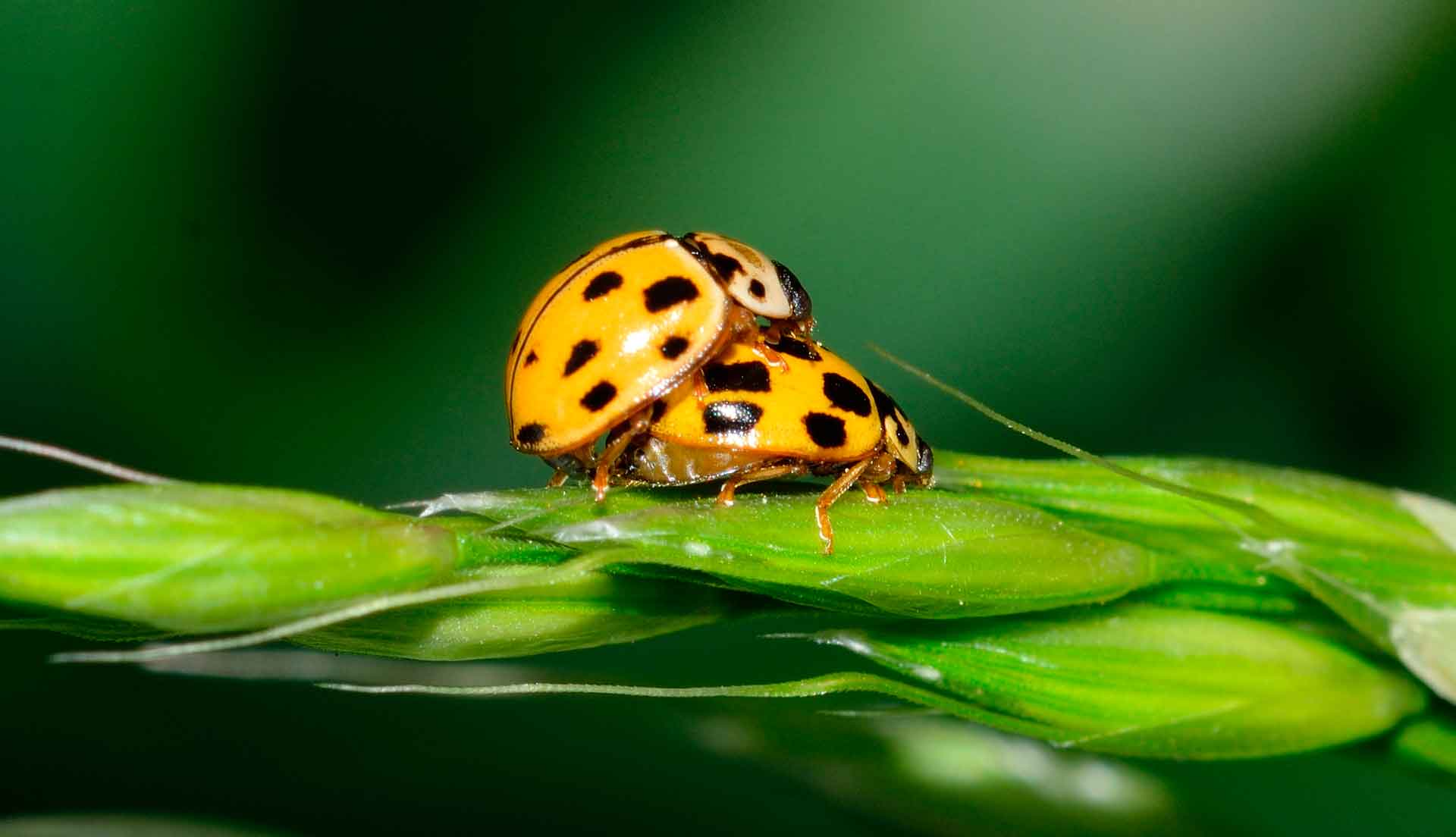
Ladybug eggs look like oval-shaped pointed grain and can be colored yellow, orange, or white. The female lays them on the underside of the leaves or the stems of the plant. One ladybug can lay up to 400 eggs, placing them in small piles. If the female eats well, then she is able to lay up to 1 thousand eggs.

After about a couple of weeks, the motley oval-shaped ladybug larvae having a bluish-gray tint appear from laid eggs. The larva of a ladybug has thin setae on the body and a peculiar pattern, which is formed by a combination of orange, yellow and white spots. Hatched, the ladybird larva eats the shell of its egg and the dead eggs. When the larva gets stronger, it begins to destroy the colonies by aphids. On the day, the voracious larva of a ladybug eats up to 300 aphids.

In the larvae stage the ladybug will be about 4-7 weeks. All this time, the ladybug larva is very mobile, because it is in constant search of food. Then the larva of a ladybug turns into a pupa and attaches to the plant. As it develops, it begins to acquire all the characteristic signs of a full-fledged insect. After about 10 days, a fully formed adult appears from the cocoon.
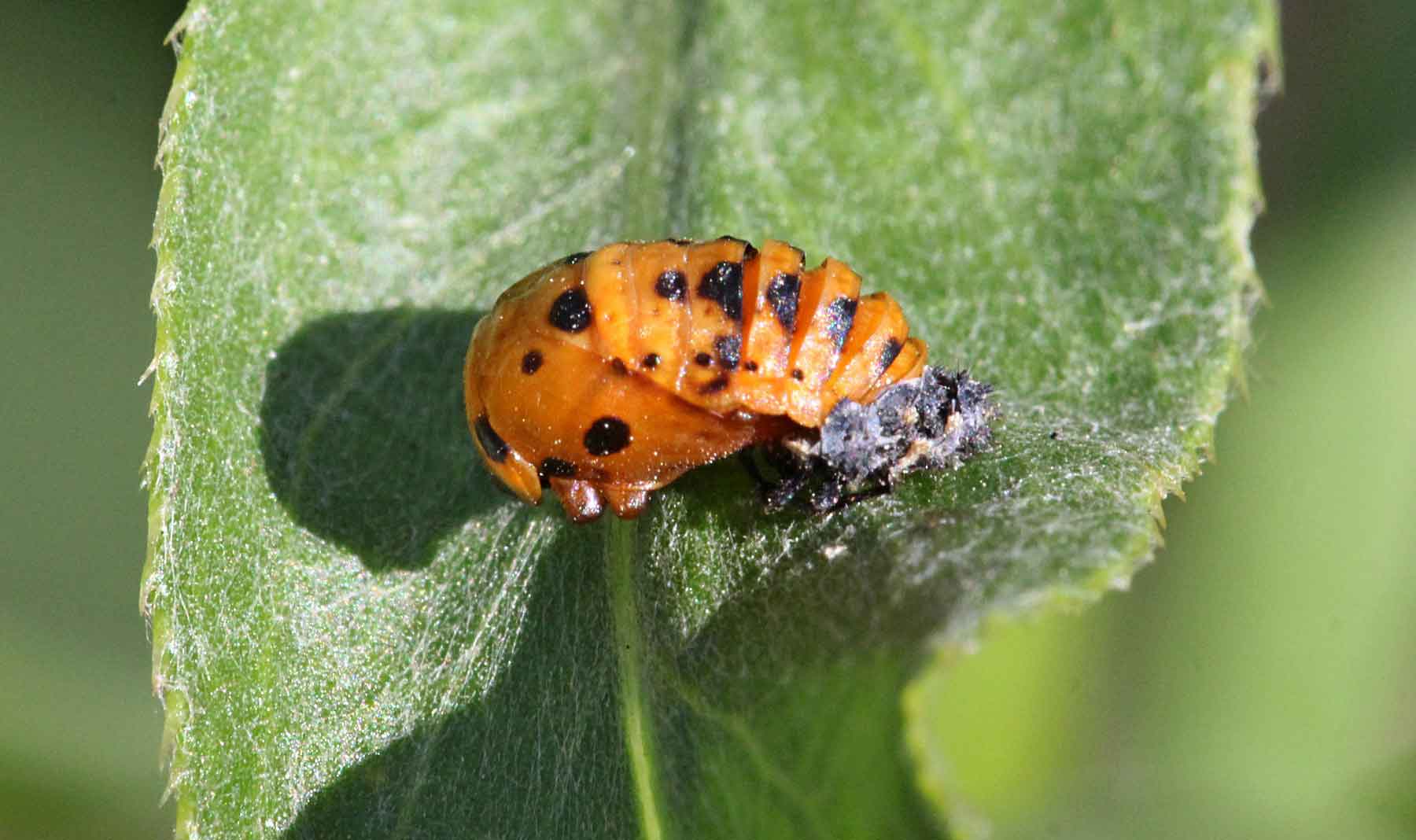
Still remains a mystery why the ladybird is so called. Perhaps it was called so because of the fact that the insect ladybug is able to release "milk" - a poisonous yellow liquid that scares off enemies. A "god" it may have been nicknamed for its harmless nature and help in preserving the crop by destroying the aphid.
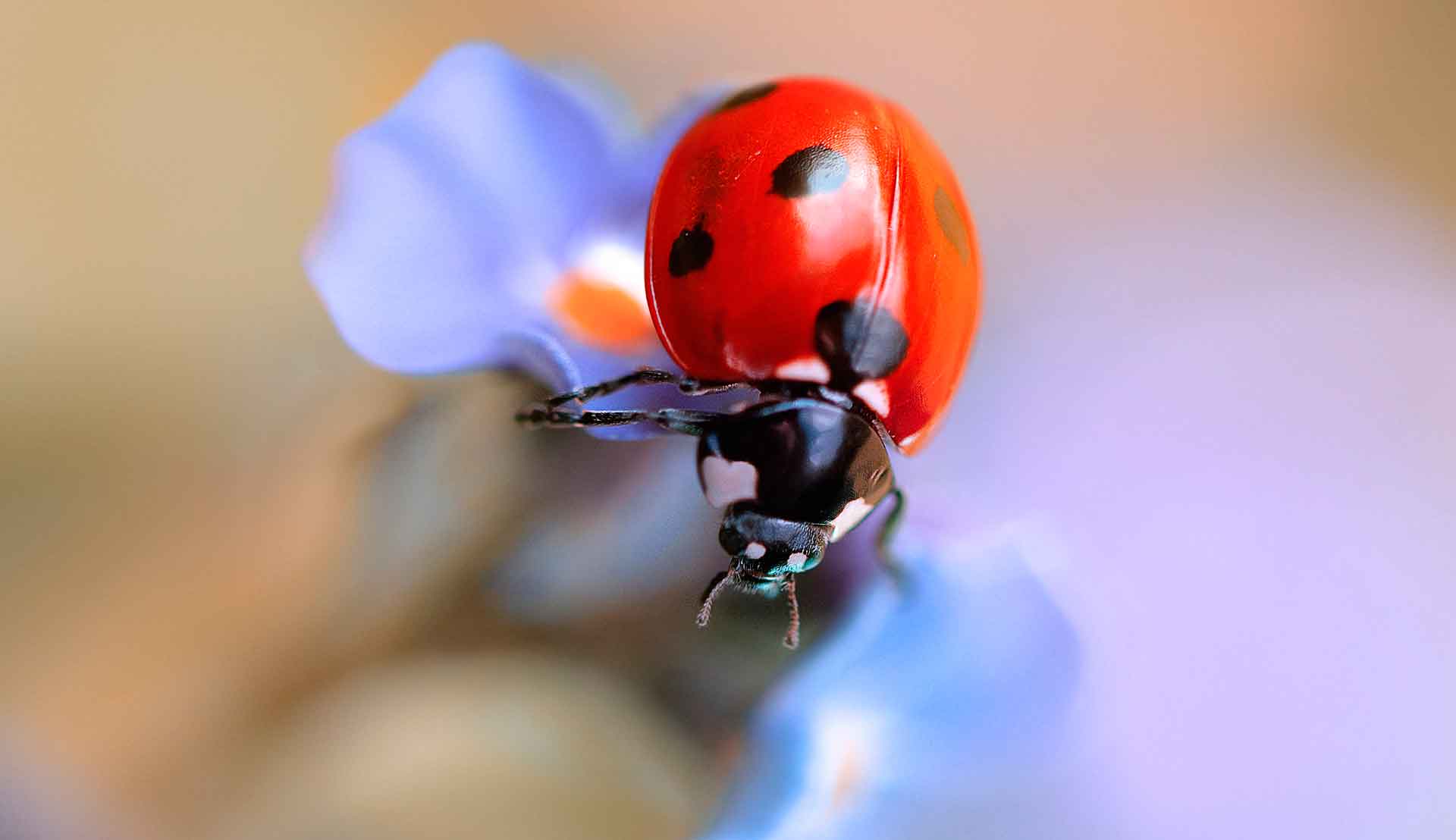
Insect ladybug all over the world enjoys great sympathy and respect. In different countries, the ladybird is called differently. In Germany, Austria and Switzerland, the ladybird is called the “beast of the Blessed Virgin Mary”. In England, the United States and Australia - "Lady Beetle". In the countries of Latin America - “the cow of St. Anthony”. In the Czech Republic, Slovakia, Belarus and Ukraine, it is called "the sun." In some countries, monuments have been erected in honor of the ladybug.
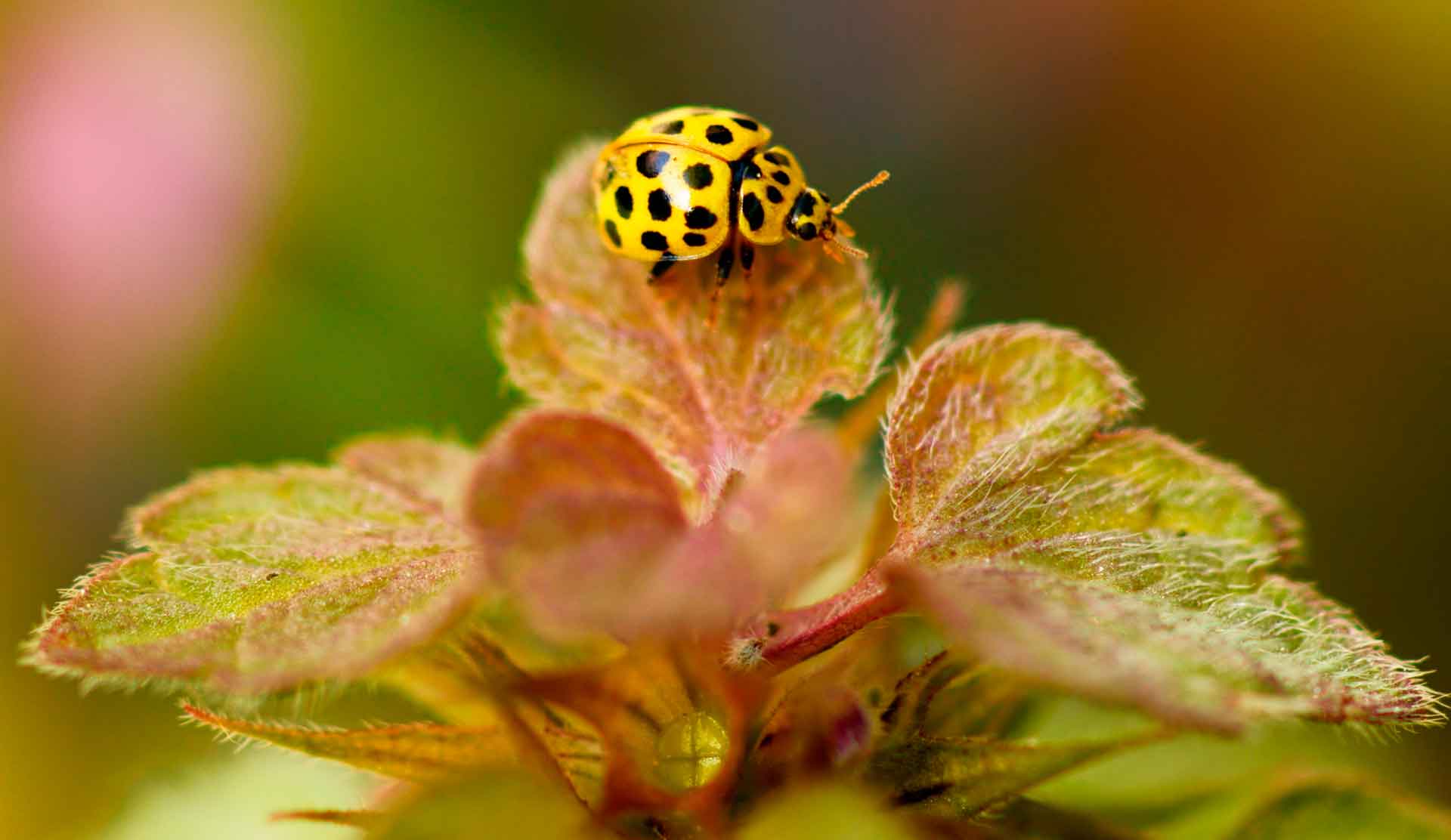
Around this insect there are many beliefs and signs that foreshadow only good events. With the participation of a ladybug there are many legends. Ladybird is considered a symbol of good luck, in ancient times people worshiped this insect and worshiped it. The image of this beetle on clothing or various decorations were considered a talisman. In some cultures it is forbidden to harm this insect so as not to attract trouble.
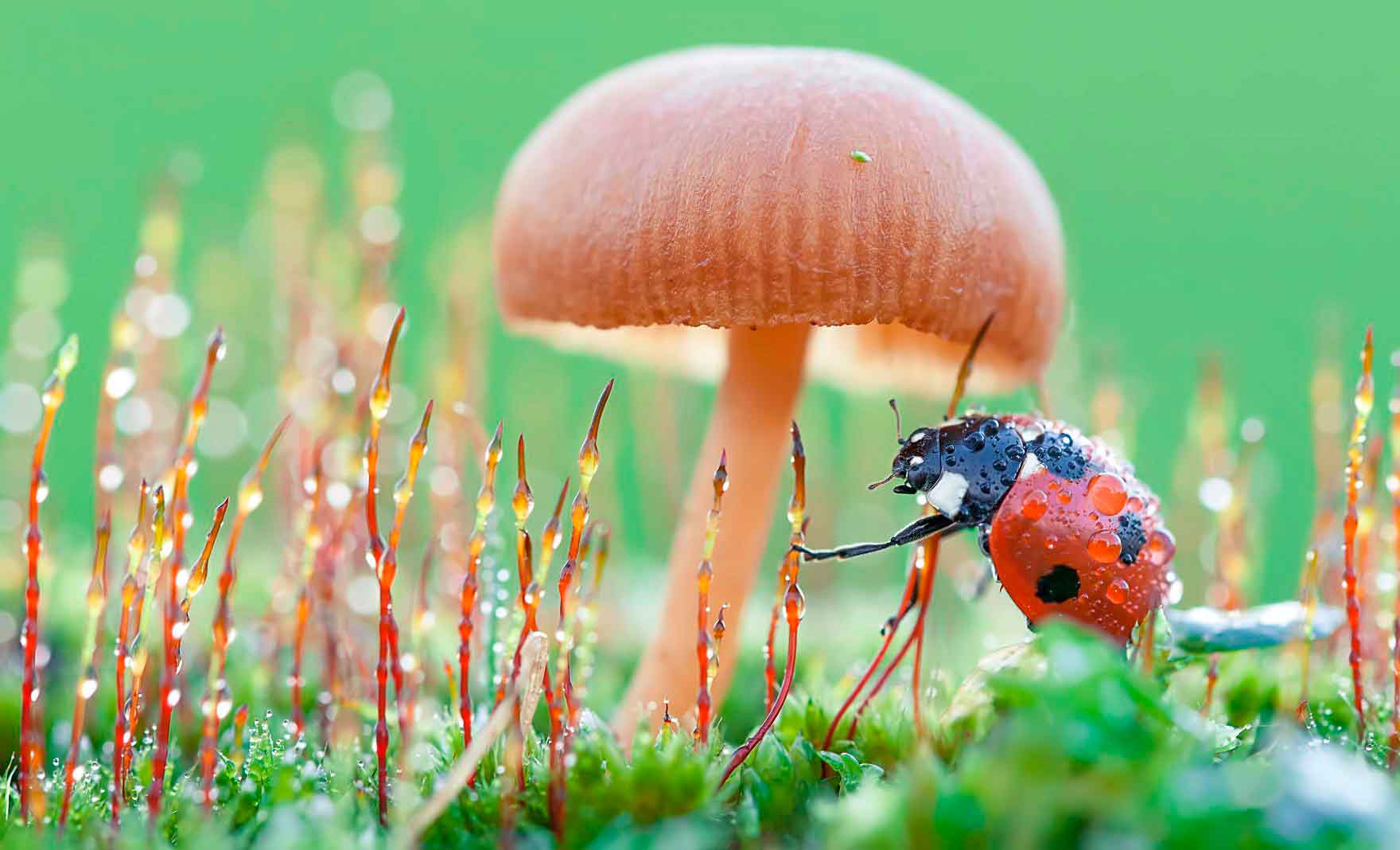
The ancient Slavs considered the ladybird the messenger of the sun goddess. It is believed that you can not chase the ladybug, which sat on you, so as not to frighten fortune. If she flew into the house, she brings peace and harmony into it. Even the weather was predicted with its help. This amazing and tiny insect with the simple name ladybird has such a universal love.

If you liked this article and you like to read about animals, subscribe to site updates to get the most recent and interesting articles about animals first.
Small beetles with a strongly convex rounded body. The lower side of the body is flat. The head is very small. The color is usually bright of contrasting black, yellow, red tones. Legs are thin, short, black. Heat-loving insects, in sunny weather, crawling hastily, quickly take off and again sit on the plants in search of food. Disturbed beetles secrete a sharply smelling, yellowish, poisonous liquid that scares off enemies. Beetles and larvae live openly on plants, mainly predators, only a few species are herbivorous and can harm crops. Predatory species destroy aphids, chervets, leaf beetles and other dangerous pests of garden and garden crops.
| (Adalia bipunctata)
Variable in color, usually with a black pronotum and red elytra having one black spot each. Body length up to 5 mm. Beetles and larvae destroy aphids. Especially useful in fruit gardens. |
|
Pronotum black, with yellow pattern. The elytra is reddish, with 9–10 black oculate spots on each. Body length up to 9 mm. Beetles and larvae feed on aphids living on conifers. |
|
Black beetle with 4 large red spots on the sheath. Body length up to 6 mm. Common and ubiquitous species. Beetles and larvae destroy sedentary insects that live in colonies on plants and suck their juices: shield insects, Hermes and Chervets. |
|
Pronotum yellow, with 4 black, sometimes merging spots. Elytra yellow, each with 7 oblong spots, which often merge into longitudinal and transverse stripes. Body length up to 5 mm. Beetles and larvae feed on aphids. |
|
Pronotum and elytra yellowish-brown, on each elytra 5-7 large light spots, which in the middle part form two transverse rows. Body length up to 6 mm. Beetles and larvae feed on aphids and leaflets. |
|
The beetle is black; its pronotum has 2 white spots. Elytra red, with 7 black spots. Body length up to 8 mm. The cow meets all summer, destroys aphids on various plants. During the day, the beetle eats from 10 to 40 aphids. The female lays up to 700 eggs. Particularly voracious bluish, with red spots of larvae, eating an average of 50 aphids of various sizes per day. In the fall, the cows flock together and hibernate in large accumulations under plant debris, usually at warm places. After wintering, ladybirds appear in early spring. |
|
Beetles with yellow pronotum, on which there is a black spot with 4 lobes on the anterior margin. Elytra intense red, on each elytra 3-6 black spots. One unpaired black spot located at the base of the elytra. Body length up to 6 mm. Beetles and larvae are found in aphid colonies on various plants. The species is one of the main natural enemies of aphids. |
|
The black beetle, which has 2 red spots on its elytra, of which only the front is sometimes retained. The body is covered with hairs. Body length up to 3 mm. Beetles and larvae feed on serious pests of plants - aphids and scale insects. For the entire development cycle, one beetle destroys more than 600 copies of the pest. |
Ladybugs (Coccinellidae)
Beetles are easily recognizable by their appearance - the body is hemispherical, usually short-oval, convex at the top, flat below, legs short. Antennae are small with a small mace at the end. The color of beetles is typical, in which rounded spots or stripes are scattered over a bright, rarely black background. There are about 75 species in the fauna of Baikal Siberia, more than 4,000 species of ladybirds are known in the world fauna.
Why did these beetles get such a strange name? Obviously because there are cows of different colors, with dark and light spots. And the "god" - because these beetles give the impression of harmless creatures: they do not sting, do not bite, and only when caught, release the yellow "milk". The bright coloring of the ladybirds warns of their inedibility. Ladybugs are successfully used in biological warfare. The main food of ladybirds is aphids, listoblushki, coccides, which deplete the plants, sucking juices and contaminating the stomata of leaves with their secretions. Cows laying eggs attach them to the places where sucking insects accumulate, and the released larvae immediately attack the prey.
One of the most interesting moments in the biology of the ladybirds is their seasonal migrations and massive accumulations of beetles at wintering sites. Some cows form clusters on stony slopes and walls of buildings in the fall, gradually climb into the cracks and overwinter there. During the migration of cows, the cliffs and walls of houses are entirely covered with beetles. The reasons for the formation of clusters of cows are not completely clarified.
Some species live mainly on trees, others on grass, and others on vegetation of any type. In the crowns of trees is usually a ladybug harmony (Harmonia axyridis) with a very volatile pattern. Elytra yellow or orange, with 19 black spots, which partially disappear or merge, forming a sling. Bright pronotum forms with M-shaped dark spot in the middle. Body length 7.4-8.2 mm. The body of the larvae is colored dark with a yellow or red pattern and has branchy outgrowths. Pupa is orange-red with black spots attached to the plants by the posterior end of the body.
Deciduous and coniferous forests are common. octopus (Anatis ocellata). The elytra brown, each with 10 elongated spots, bordered by bright rims, often the spots are connected in longitudinal stripes, or sometimes disappear. Pronotum brown with large black spots. Body length 7.5-9.0 mm. The pupa is spotty, light, with jagged processes on the sides of the abdomen. In the same places lives three-strip ladybug (Coccinella trifasciata). Pronotum black, with anterior triangular whitish-yellow spot. Elytra yellow, orange-red or red, with three wide black transverse stripes. Body length 4.0-5.6 mm. The pupa is red, with black spots. On tree and shrub vegetation, as well as on the meadows in large quantities seven-point bug (Coccinella septempunctata). Pronotum black with small yellow spots on anterior corners. Scutellum black, elytra red with 7 black dots. Body length 5.2-7.0 mm.
|
|
|
Seven-spotted ladybug (Coccinella septempunctata) |
In herbs is common changeable ladybug (Adonia variegata). Pronotum black with yellow lateral edges and usually with 2 spots in the center. Elytra yellowish, each with 6 black dots and one common point on the shield. Points may merge or fade. The bottom of the body is black, the legs are brown-yellow, and the hips are dark. Length 3.0-5.5 mm. The larva is blue-black, with red spots, covered with spiny warts.
|
|
|
|
Cow changeable (Adonia variegata) |
The larva of the mug is changeable |
Seven-spotted cow (Hippodamia septemmaculata) is common in wet meadows. The head is black, with large yellow spots on the front edge. Pronotum black with yellow edges. Elytra orange or yellow with a large common spot at the shield and 3 or 5 black spots. The bottom of the body and legs are black, the paws are brown. Body length 5.0-7.8 mm.Mannerheim's Cow(Coccinella hieroglyphica mannerheimi) is less common. The head is black with 2 small yellow spots on the forehead and near the eyes. The pronotum is black with 2 yellow spots on the front corners and a narrow strip on the sides. Elytra yellowish brown with 2 black transverse bands. The bottom of the body is black. Body length 3.5-5.0 mm.
The Latin name of a ladybug sounds like “coccineus” - it means “scarlet”. That bright bright coloring was the basis for such a name.
In different countries, this bug is called differently, but each of the names indicates people's love and respect for it.
Latin Americans call it “the cow of St. Anthony,” the Germans and the Swiss call it “the bug of the Virgin Mary,” the Czechs and Slovaks call it “The sun”, and the Russians, Ukrainians, and Belarusians, the “ladybird.” Let's find out what brings this insect to ours - benefit or harm, where it lives and what it feeds on.
Description and types
A beautiful bug with spots on the wings - all the inhabitants of the country are well aware of this insect and have seen them more than a dozen times in their own gardens.
The length of the little body of the beetle can be from 5 to 8 mm. In our country, the most common ladybug with seven points on the shell ("Seven-point"). An elegant bug was nicknamed for seven dark spots on scarlet wings.  Periodically there are bugs, painted unusually:with yellowish wings and dark dots or black with white spots on the shell, and even completely without points.
Periodically there are bugs, painted unusually:with yellowish wings and dark dots or black with white spots on the shell, and even completely without points.
The spots may be more or less than seven, the color of the elytra may also be in several variants. Worldwide, there are about five thousand types of ladybirds.
A ladybug feeds in nature and an armor-clad and, what saves the gardens and. The insect insects of the world are formidable aphid exterminators, living on the back of garden and garden leaves.
Did you know? In many countries, there is such a direction of agricultural business as breeding ladybirds. Farmers are seriously engaged in these beneficial insects, the whole cycle of development of bugs is under strict control. In the future, insects are sold to farmers and the bill goes to thousands of individuals in each lot. Aphid hunters are sold both in the country where they were raised and sent by mail all over the world.
Life cycle features
Adult members of the family live and hibernate in the open field, hiding in the dry folded leaves or under dried blades of grass. With the onset of heat, it is time to breed the offspring and the beetles lay a clutch of 10-20 eggs. 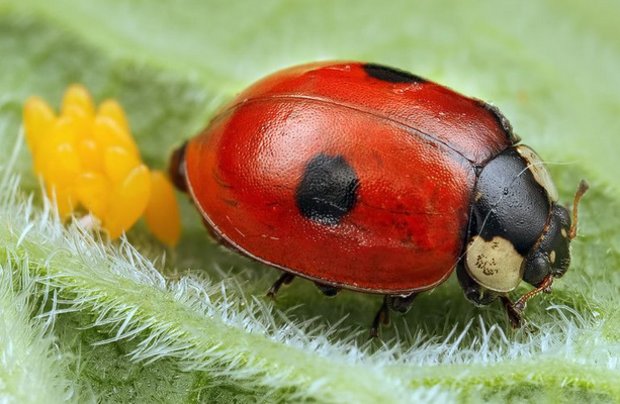 The masonry is attached either on the bark of vertical branches, or on the inside of the leaf blade, not far from the aphid settlement. From eggs to adulthood, insects gradually go through four stages.
The masonry is attached either on the bark of vertical branches, or on the inside of the leaf blade, not far from the aphid settlement. From eggs to adulthood, insects gradually go through four stages.
The larvae of these insects have a brown-gray color; as the pupation time approaches, the color of the cover changes to a pale yellow. When the young beetle emerges from the pupa, it takes a little time for the elytra to finally become scarlet.
Larvae, like adults, mainly feed on aphids; this species belongs to predatory insects.Throughout the entire life cycle, the female beetle lays about a thousand eggs, of which will eventually hatch, grow and give birth to a new generation of a thousand young bugs.From laying eggs to the release of the adult beetle in the summer takes 40-60 days. The biological value of a ladybug is hard to overestimate: only one female beetle destroys up to four thousand aphids throughout its life, thereby saving plants that occupy half a hectare of land from destruction.
A funny bug with red wings to a small dot familiar to all from childhood can destroy a little more than 150-170 individuals of leaf-sucking aphids in one day. 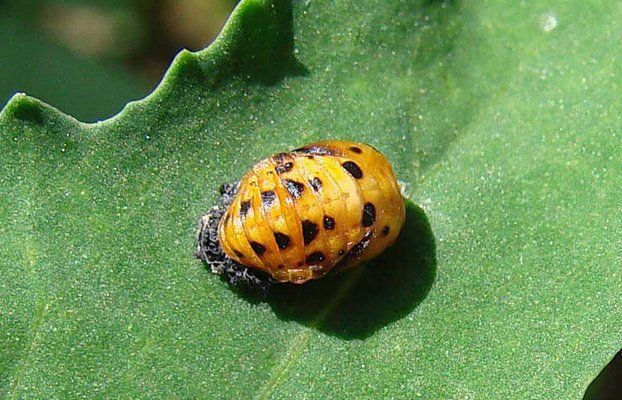
Important! The larva of this beetle has a not very attractive appearance - it is a strange creature without wings and with bright dots on its back. If you see such a monster on your loved ones or - do not rush to destroy it, soon this larva will turn into a cute colorful bug.
What is the use
The benefits that a ladybug brings are visible to the naked eye, one has only to look closely at, for example, cucumber. The reverse side of the leaf is dotted with aphids actively sucking the leaves.
If left alone, in four days the leaves will dry completely and the plant will die. But now the scarlet hunters begin their work, and the cucumber plantations will be cleared of the day. 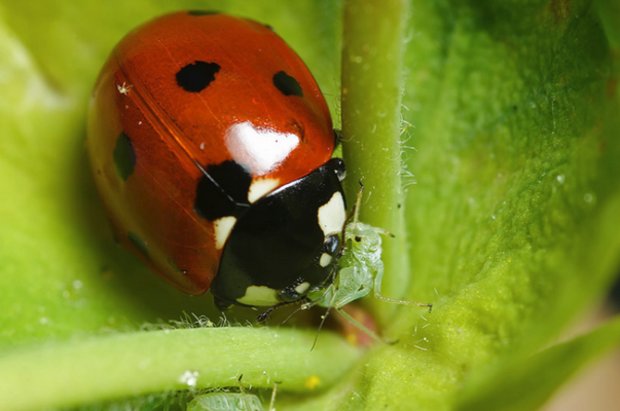 It is the presence of these carnivorous insects that solves problems with the destruction of aphid colonies on berry bushes, fruit trees, and on. The ability to do without chemical treatments will allow you to eat ripe fruit and fruits without fear.
It is the presence of these carnivorous insects that solves problems with the destruction of aphid colonies on berry bushes, fruit trees, and on. The ability to do without chemical treatments will allow you to eat ripe fruit and fruits without fear.
Some gardeners in the early spring, seeing on some plants small colonies of aphids, immediately begin to resort to the destruction of their pesticides. No need to completely destroy the plant louse on plants, because adult ladybugs without food will die.
With the onset of autumn, there is no need to ideally clean the garden and garden from fading plant debris, because in the absence of dry fallen leaves, empty birdhouses or heaps of brushwood left for the winter, ladybirds will have no place to wait the cold period safely.
Did you know? There is such a sign that heralds close luck in anything: if a ladybird lands on your palm, then you can expect unexpected joy, good luck. The flown insect is not shaken off the hand in any way in order not to shake off luck, but wait until it flies away of its own accord.
Is there any harm
Although the benefits of the activity of beetles significantly exceeds the harm they cause, it is still there. Not everything that ladybirds eat is for the benefit of the plant world.
Since the bug is a predatory and carnivorous insect, in addition to the aphid, it can eat other insects that are useful for the garden and vegetable garden.
There are several types of ladybirds, causing significant damage to cultural plantings:
He lives in hot countries (Africa, Asia, Turkmenistan, Azerbaijan). It also has a widespread distribution in some European countries.
It causes great damage to the crop. Our climate melon ladybirds are not suitable because of the harsh winters.  - is a real "scourge of God" for planting, and in the Amur region, the Khabarovsk Territory and on the Sakhalin Peninsula.
- is a real "scourge of God" for planting, and in the Amur region, the Khabarovsk Territory and on the Sakhalin Peninsula.
In some places, such a bug is called a potato cow. This insect not only harms crops, vegetables, and, but also spreads viral plant diseases from field to field.  , or multicolor Asian - aggressive and voracious creatures, from this type of beetles in a panic farmers of North America, Western Europe and England. In 1988, these insects were brought to North America.
, or multicolor Asian - aggressive and voracious creatures, from this type of beetles in a panic farmers of North America, Western Europe and England. In 1988, these insects were brought to North America.
With their help, it was proposed to establish biocontrol over the untamed spread of aphids. But this species destroys not only aphids, but also representatives of its own species and today it has become the most common species in the United States and Great Britain.  The biologists of these countries are sounding the alarm - the remaining 46 species of cows, which were previously widespread, have almost disappeared.
The biologists of these countries are sounding the alarm - the remaining 46 species of cows, which were previously widespread, have almost disappeared.
Important! A gardener who wants to preserve the population of these elegant bugs on his territory must be remembered that any processing of the garden will lead to the death of not only harmful insects. After treatment with pesticides, pests quickly restore their numbers, but useful beetles reproduce more slowly.
How to attract ladybugs
Attracting beetles to your garden or garden is not very easy, but possible. For this you need to plant the plants that attract this insect to settle on your territory.
Gardeners have long noticed that these bugs lure the smell of planting,.
Experienced gardeners leave comfortable places for wintering to handsome beetles - if such shelters are prepared deliberately and in places convenient for insects, then insects willingly stay in them to winter.  Long known technique:after harvesting, they clean the corn heads in dry bunches and hang up such “bouquets” in the garden or on - where the ladybirds eat.
Long known technique:after harvesting, they clean the corn heads in dry bunches and hang up such “bouquets” in the garden or on - where the ladybirds eat.
In September, in search of a warm, dry and cozy shelter for wintering, insects are willingly packed in large numbers in corn “courtes” kindly provided by them.
Gardener can only be collected at the end of September, covered with sitting bugs "hibernation", move them to the barn and hang from the ceiling beams. In the spring, the beetles will leave the winter shelter themselves and scatter about their business.
These insects will remain for the summer in your garden and your garden. It must be remembered that even with a dozen ladybugs will cause great damage to the aphid army.Even if the owner did not take care of gathering hunters for aphids for wintering, they will find shelter in the yard: in the woodpile of wood, under the bark of old, under a pile of leaves or shavings.  All representatives of the insect world hide there and overwinter by a dense friendly company. For our climate, it is important that such shelters are low from the surface and snow covered them in winter, saving the beetles from freezing.
All representatives of the insect world hide there and overwinter by a dense friendly company. For our climate, it is important that such shelters are low from the surface and snow covered them in winter, saving the beetles from freezing.
In European countries, special garden "houses for ladybirds" are sold in stores for gardeners. Such small houses look like mailboxes or mini-birdhouses.
Houses for useful beetles are made from natural materials (, bamboo, plant debris, vine).
In the summer, insects do not fly into such a house, since they do not need shelter during the warm period, and in order to lure them to the house and invite them to stay for the winter, people lay out a bait containing pheromones in these boxes.
Such a house is very decorative and decorates the garden, but at the same time it is designed so that the insects will not carry snow in winter and they will be able to survive the cold without loss.  “A cow, a ladybird, fly to the sky - there your children eat candy”, - one of the children in childhood, having put a finger up, did not wait with bated breath, when after these words the ladybug would spread its wings and take off ...
“A cow, a ladybird, fly to the sky - there your children eat candy”, - one of the children in childhood, having put a finger up, did not wait with bated breath, when after these words the ladybug would spread its wings and take off ...
This is a piece of childhood for every adult. Ladybug is a small summer bug with bright elegant color of wings, pure children's joy and a tireless assistant gardener in the fight against garden pests.
Gardeners should create comfortable living conditions for them and they will stay in our gardens for a long time - decorating and saving them.
Was this article helpful?
Well no
October 28, 2009 0 No comments 12,985 views
You probably wondered more than once why the ladybird is called that? After all, this tiny and harmless creature does not look like a cow. And about the epithet "God" and sovsme incomprehensible. As for the word “ladybird”, the biological feature of the insect comes into force: in case of danger, milk from the pores on the folds of the legs of the beetle scares off the predators. As for the word “god”, there are several versions. One of them is the belief that this insect is directly connected with God, it lives in the sky and only occasionally descends to the earth. At the same time, she plays the role of a real messenger, she can find out what the weather will be like, whether the harvest will succeed, etc. This is reflected in other cultures: in Germany it is called the Marienkaefer (beetle of the Holy Virgin Mary), in England - the Ladybird (Lady Birdie, the Bird of the Virgin), in Argentina - the Ladybird of St. Anthony.
(13 photos total)

1. Harlequin ladybugs spend the winter in covered areas - usually in large groups. (Nick Greatorex-Davies / Center for Ecology & Hydrology / PA)
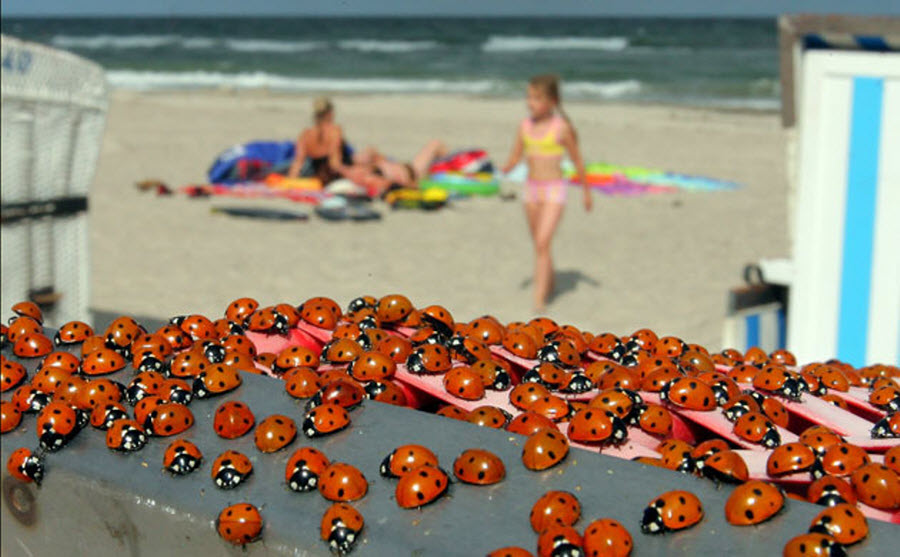
2. Ladybugs flooded the beach of Warnemundé, Germany. Ladybug harlequin lives in Asia. In North America and continental Europe, she was represented as a major fighter against aphids. (Bernd Wuestneck / EPA / Corbis)
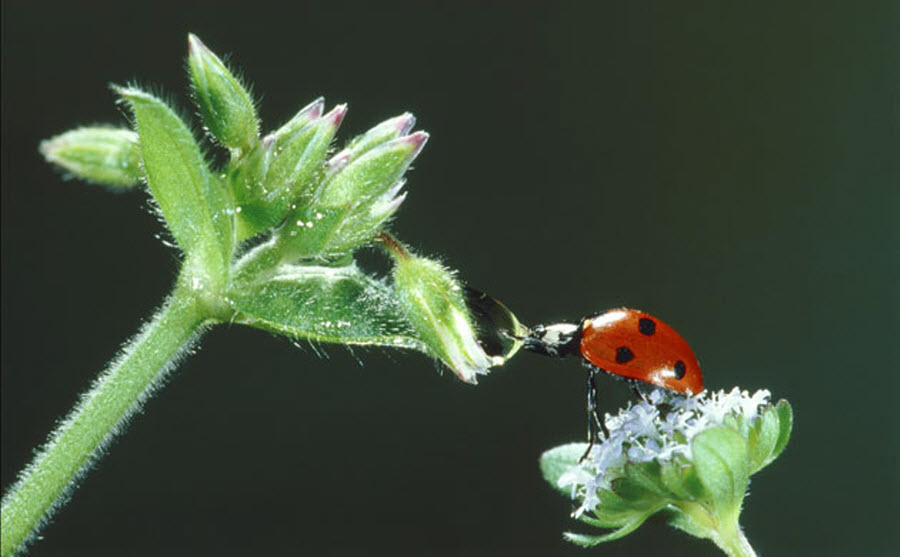
3. Unfortunately, the harlequin ladybug also eats local species of ladybirds, as well as their food. (Fritz Rauschenbach / Corbis)
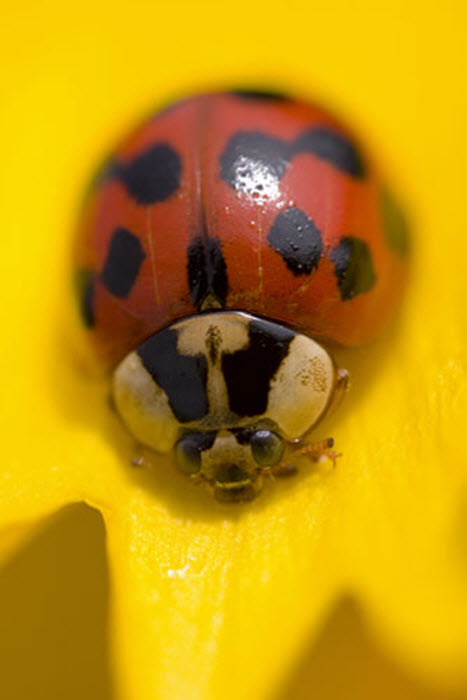
4. The harlequin of a ladybug is quite diverse in appearance, so it is difficult to distinguish them from other species. (Craig Tuttle / Corbis)
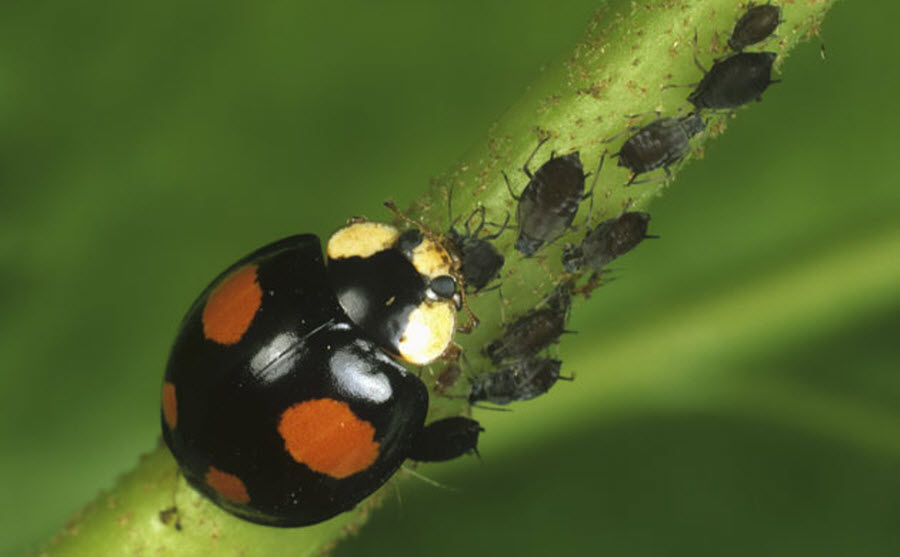
5. Black Harlequin ladybug with four red dots eats aphids. (Nigel Cattlin / Visuals Unlimited, Inc./Getty Images)
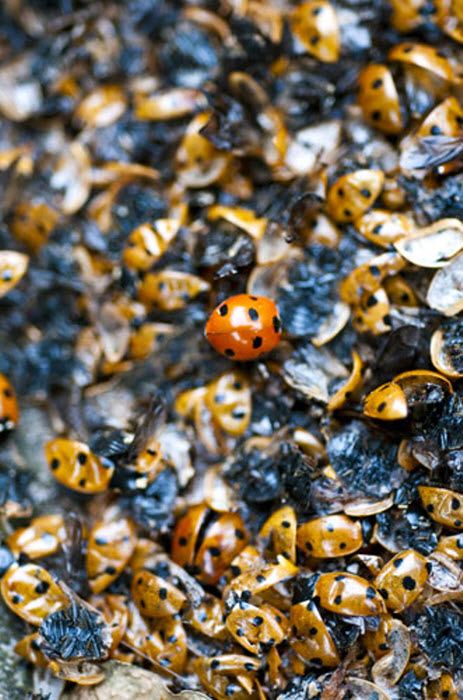
6. Thousands of corpses of ladybirds with seven points on their backs lie on the streets of Cromer after they filled the coastal city of Norfolk. (Jason Bye / Rex Features)

7. Ladybird with two dots laying eggs. Ladybugs with two points are almost half the size of harlequins. (Robert Harding / Rex Features)
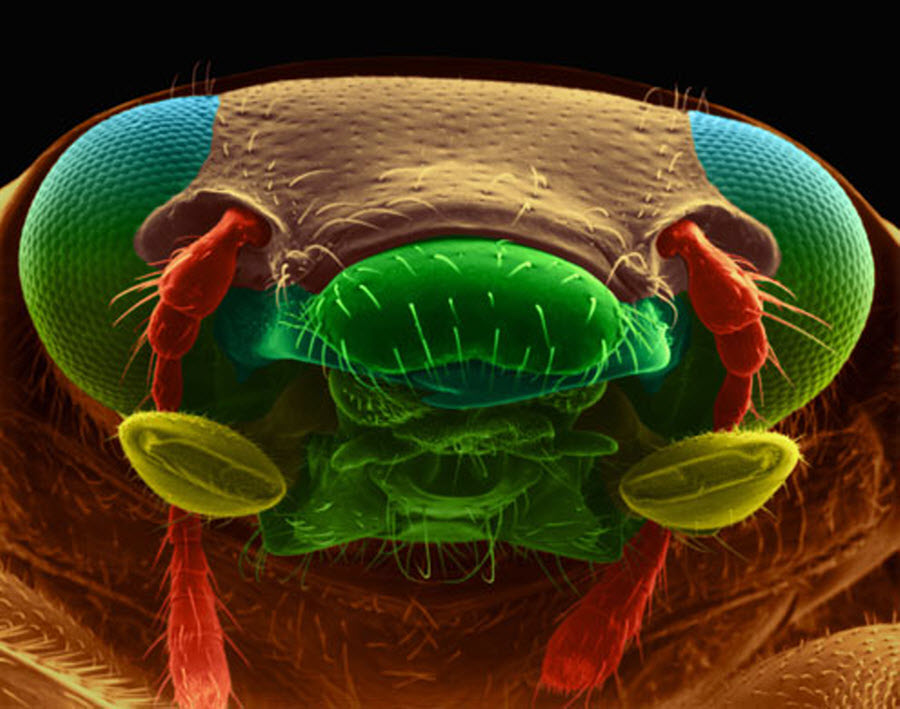
8. Detailed view of the head of a ladybug - mouth, antennae and complex structure of the eye. (Dennis Kunkel Microscopy / Corbis)
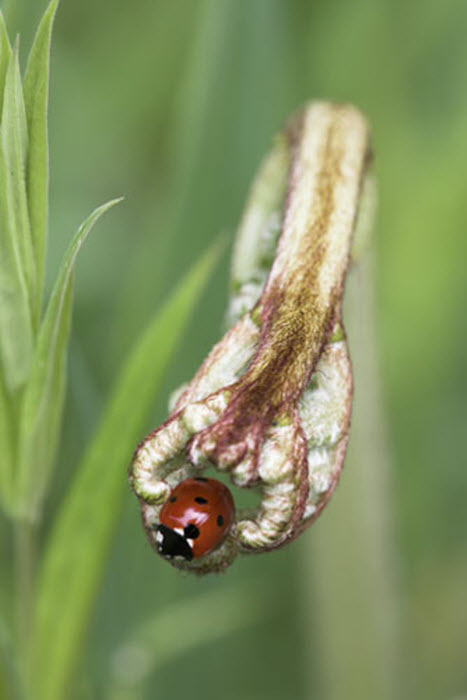
9. Ladybug with seven points. (Steve & Ann Toon / Robert Harding World Imagery)

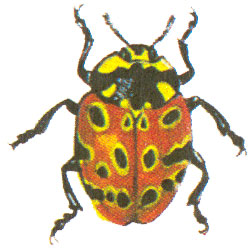 (Anatis ocellata)
(Anatis ocellata) (Exochomus quadripustulatus)
(Exochomus quadripustulatus)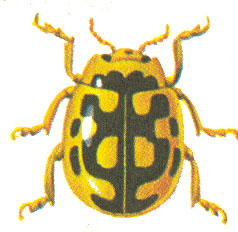 (Propylaea quatuordecimpunctata)
(Propylaea quatuordecimpunctata) (Calvia quatuordecimguttata)
(Calvia quatuordecimguttata)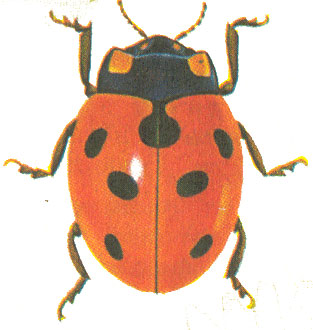 (Coccinella septempunctata)
(Coccinella septempunctata) (Adonia variegata)
(Adonia variegata) (Scymnus frontalis)
(Scymnus frontalis)
